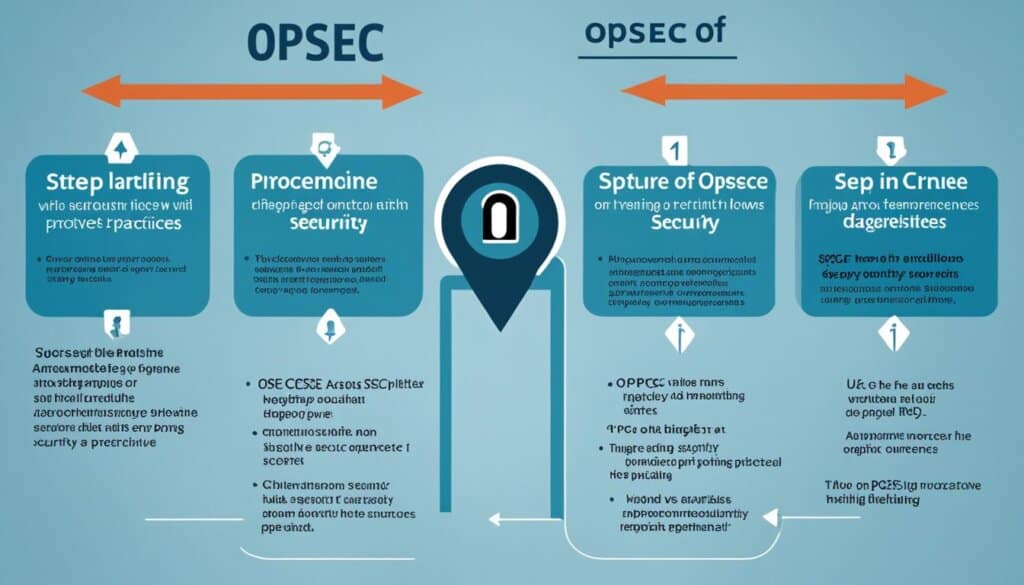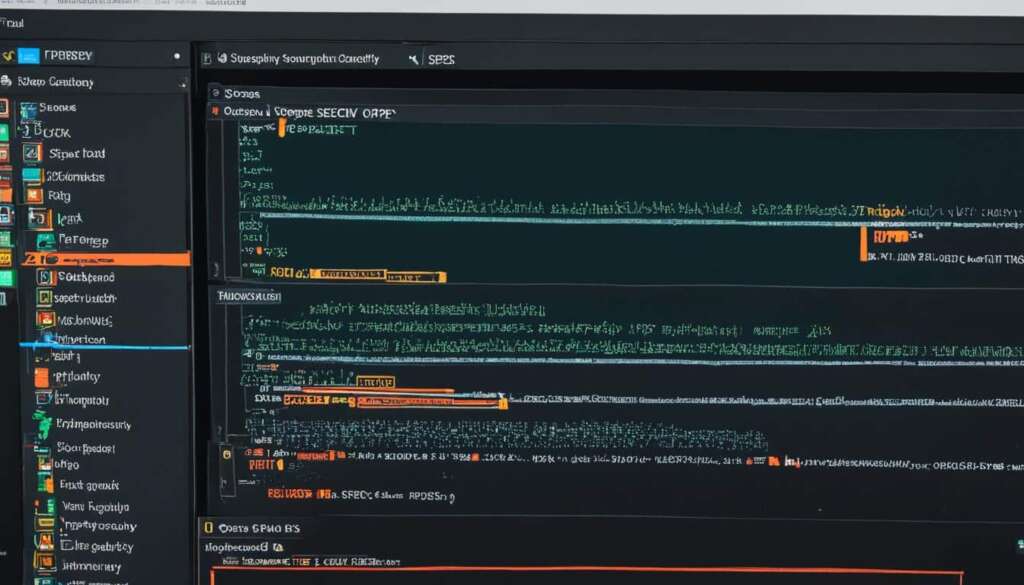Table of Contents
OpSec, short for operations security, is a critical aspect of safeguarding personal and organizational data. This practice involves classifying and protecting sensitive information to prevent unauthorized access and potential threats. Originating from the Vietnam War, OpSec has now become widely adopted across both government and private sector organizations.
Implementing OpSec best practices is crucial for effective security. By following change management processes, employing least-privileged access, implementing dual control, automation, and disaster recovery planning, organizations can ensure the protection of personal and organizational data.
In this article, we will explore what OpSec is, the five steps involved in the OpSec process, and the best practices organizations can implement to enhance their security posture. We will also highlight the relationship between OpSec and risk management, the importance of OpSec in today’s interconnected world, and the origins of OpSec during the Vietnam War.
Stay tuned to learn how OpSec can play a crucial role in safeguarding sensitive information and mitigating cyber risks.
What is OPSEC?
OPSEC, also known as operations security, is a critical process for safeguarding sensitive information and protecting it from unauthorized access. Originating from military practices, OPSEC has now expanded its reach to other sectors, aiding in the protection of valuable data and guarding against potential attackers.
OPSEC encourages organizations to adopt a proactive mindset, viewing their operations and systems from the perspective of potential attackers. By analyzing threats, vulnerabilities, and risks, organizations can develop comprehensive strategies to prevent sensitive information from falling into the wrong hands. It is essential to employ risk management processes alongside OPSEC measures to ensure the effective protection of critical data and mitigate potential cyber threats.
“OPSEC aims to prevent unauthorized access to sensitive information by identifying potential vulnerabilities and implementing appropriate countermeasures.”
An Overview of OPSEC’s Key Components:
- Classification: Identifying and categorizing critical information based on its level of sensitivity and potential impact.
- Threat Analysis: Evaluating potential attackers and their motivation to obtain sensitive information.
- Vulnerability Analysis: Assessing the weaknesses and gaps within an organization’s security measures.
- Risk Assessment: Determining the likelihood and potential impact of an attack.
- Countermeasures: Implementing appropriate measures to mitigate identified risks, such as access controls, encryption, and monitoring.
By following OPSEC best practices, organizations can significantly enhance their security posture and minimize the likelihood of data breaches or unauthorized access to sensitive information. The integration of OPSEC within an organization’s overall cybersecurity framework provides a comprehensive and proactive approach to protect against potential threats.
OPSEC Image
The Five Steps of OPSEC
The OPSEC (Operations Security) process is composed of five critical steps that organizations must follow to ensure the protection of sensitive information and mitigate security risks.
Step 1: Identifying Critical Information
The first step in the OPSEC process is identifying the critical information that requires safeguarding. This includes intellectual property, customer data, financial statements, product research, and any other information that is vital to the organization’s operations and security.
Step 2: Analyzing Threats
Once the critical information has been identified, the next step is to analyze potential threats. These threats can come from various sources, including competitors, hackers, or other malicious actors. Organizations must assess the likelihood and potential impact of these threats to determine the necessary security measures.
Step 3: Analyzing Vulnerabilities
To effectively protect critical information, organizations must analyze the vulnerabilities present in their existing security measures. This analysis involves assessing both physical and electronic safeguards to identify any weaknesses or potential entry points that could be exploited by threat actors.
Step 4: Assessing Risks
After identifying the vulnerabilities, the next step is to assess the associated risks. This assessment includes evaluating the likelihood of an attack and the potential consequences of a successful breach. By understanding the risks involved, organizations can prioritize their security efforts and allocate resources appropriately.
Step 5: Applying Countermeasures
The final step in the OPSEC process is applying countermeasures to mitigate the identified risks. These countermeasures can take various forms, including hardware updates, employee training, and information governance policies. By implementing these countermeasures, organizations can effectively reduce the risks and enhance their overall security posture.
“The OPSEC process ensures the protection of critical information and helps organizations stay one step ahead of potential threats.”
Implementing the OPSEC steps is crucial for organizations to safeguard their sensitive information and maintain a robust security posture. By following this process, organizations can identify, analyze, and mitigate security risks effectively.
| OPSEC Steps | Actions to be Taken |
|---|---|
| Identifying Critical Information | Identify intellectual property, customer data, financial statements, product research, and other crucial information. |
| Analyzing Threats | Assess potential threats, including competitors and hackers, to determine the organization’s vulnerability. |
| Analyzing Vulnerabilities | Evaluate physical and electronic safeguards to identify weaknesses and potential entry points. |
| Assessing Risks | Evaluate the likelihood and impact of potential attacks to prioritize security measures. |
| Applying Countermeasures | Implement hardware updates, employee training, and information governance policies to mitigate risks. |

Operations Security Best Practices
Implementing operational security best practices is essential for creating a comprehensive security program. By following these practices, organizations can enhance their overall security posture and protect sensitive data from unauthorized access. The key OPSEC best practices include:
- Change Management Processes: Establishing robust change management processes ensures that network adjustments are properly documented, tested, and approved, minimizing the risk of security breaches and system failures.
- Device Access Restriction: Restricting device access to only necessary devices helps prevent unauthorized individuals from gaining access to sensitive information, reducing the risk of data breaches and potential malware infections.
- Least-Privileged Access: Adopting the principle of least-privileged access ensures that employees have access only to the information and resources essential for their roles, mitigating the risk of insider threats and unauthorized data manipulation.
- Dual Control: Implementing dual control separates network maintenance and security responsibilities, reducing the likelihood of unauthorized system modifications and enhancing accountability within the organization.
- Automation: Automating routine tasks minimizes human error and accelerates critical security processes, allowing organizations to respond more effectively to threats and vulnerabilities.
- Disaster Recovery Planning: Developing a comprehensive disaster recovery plan ensures that organizations can quickly and effectively respond to cyberattacks, minimizing potential damages and improving the chances of a swift recovery.
By incorporating these OPSEC best practices into their security strategies, organizations can significantly reduce the risk of security breaches and safeguard their sensitive data.
| Best Practice | Key Benefits |
|---|---|
| Change Management Processes | Minimizes the risk of security breaches and system failures by ensuring proper documentation, testing, and approval of network adjustments. |
| Device Access Restriction | Prevents unauthorized individuals from accessing sensitive information, reducing the risk of data breaches and malware infections. |
| Least-Privileged Access | Mitigates the risk of insider threats and unauthorized data manipulation by granting employees access only to essential resources. |
| Dual Control | Enhances accountability and reduces unauthorized system modifications by separating network maintenance and security responsibilities. |
| Automation | Minimizes human error and speeds up critical security processes, enabling prompt responses to threats and vulnerabilities. |
| Disaster Recovery Planning | Facilitates swift and effective response to cyberattacks, minimizing damages and improving the chances of recovery. |
OPSEC and Risk Management
OPSEC (operations security) and risk management are closely intertwined in the realm of cybersecurity. Organizations rely on OPSEC principles to identify vulnerabilities by viewing their operations and projects from the perspective of potential adversaries.
By conducting thorough risk assessments, organizations can assess the potential for harm and implement necessary countermeasures to protect sensitive information from unauthorized access. This proactive approach enables organizations to mitigate risks and safeguard their critical data effectively.
Identifying Vulnerabilities
The first step towards effective risk management is identifying vulnerabilities within an organization. OPSEC practices shed light on potential weaknesses by analyzing operations and infrastructure from an adversarial perspective. This enables managers to pinpoint potential entry points for attackers and develop strategies to fortify their defense systems.
Assessing Risks
Assessing risks involves evaluating the likelihood and potential impact of identified vulnerabilities. By understanding the possible consequences of a successful attack, organizations can prioritize their defenses and allocate resources to the most critical areas. This enables organizations to implement countermeasures that specifically address high-risk areas, reducing the overall impact of potential security breaches.
Implementing Countermeasures
Implementing countermeasures is a vital component of risk management. OPSEC practices provide organizations with the guidance needed to develop strategies and solutions that protect sensitive information. By integrating comprehensive security measures, organizations can better defend against potential threats and enhance their overall security posture.
- Enhanced access controls and authentication mechanisms
- Encryption technologies to protect data in transit and at rest
- Regular software updates and patch management procedures
- Employee training and awareness programs to promote a security-conscious culture
- Effective incident response plans to minimize the impact of security breaches
Protecting Sensitive Information
The ultimate goal of OPSEC and risk management is to protect sensitive information from unauthorized access. By combining robust security measures and diligent risk assessment procedures, organizations can safeguard their critical data against potential threats. This not only ensures compliance with regulatory requirements but also fosters trust and confidence among customers, partners, and stakeholders.
Illustrative Example: A Case Study in Risk Management
“Through the implementation of OPSEC practices and a comprehensive risk management approach, XYZ Corporation, a global leader in information technology, successfully identified vulnerabilities within their supply chain management system. By conducting regular risk assessments and applying countermeasures, such as implementing multi-factor authentication and conducting thorough background checks on vendors, XYZ Corporation strengthened their security posture and protected sensitive customer data from potential breaches.”
| OPSEC | Risk Management |
|---|---|
| Focuses on identifying vulnerabilities | Identifies vulnerabilities and threats before they become actual issues |
| Views operations from the perspective of potential adversaries | Assesses risks by evaluating the likelihood and potential impact |
| Guides the implementation of countermeasures | Ensures the protection of sensitive information |
By combining OPSEC practices and risk management strategies, organizations can effectively protect their sensitive information, fortify their defenses, and reduce the overall risk of cyber threats.
OPSEC Training
The Center for Development of Security Excellence (CDSE) provides comprehensive OPSEC training for military personnel, Department of Defense employees, and contractors. CDSE’s training programs aim to enhance security awareness and critical data protection through a range of educational resources and courses.
CDSE’s OPSEC training covers a wide range of topics to ensure individuals have a thorough understanding of operations security. This includes defining the principles of OPSEC, identifying critical information, understanding the five steps of OPSEC, recognizing potential threats, and applying appropriate countermeasures.
Web-based E-learning Formats
To cater to the diverse needs of participants, CDSE offers OPSEC training through web-based e-learning formats. This allows individuals to conveniently access the training materials at their own pace and from any location with internet access. CDSE’s e-learning platforms provide an interactive and engaging learning experience, combining instructional videos, quizzes, and real-world examples to reinforce key concepts.
CDSE’s Security, Training, Education, and Professionalization Portal
CDSE’s Security, Training, Education, and Professionalization Portal serves as a comprehensive resource hub for individuals seeking OPSEC training. The portal offers a wealth of educational materials, including courses, publications, videos, and guides, to further enhance security awareness and critical data protection skills.
“CDSE’s OPSEC training equips participants with the knowledge and skills needed to identify potential vulnerabilities, conduct thorough risk assessments, and effectively implement countermeasures to protect critical data.”
By engaging in OPSEC training offered by CDSE, individuals can acquire the necessary expertise to protect sensitive information and contribute to the overall security posture of their respective organizations.
The Origins of OPSEC
During the Vietnam War, Admiral Ulysses S. Grant Sharp established the Purple Dragon team to investigate how the enemy obtained information on military operations before they occurred. The team’s findings revealed that the U.S. military was inadvertently revealing critical operations-related data to the enemy. In response to this alarming discovery, OPSEC (Operations Security) was developed as a methodology to prevent adversaries from accessing sensitive information.
The Purple Dragon team’s efforts paved the way for the implementation of OPSEC across various government agencies and organizations, all of which recognized the importance of safeguarding national security.
Since its inception, OPSEC has become a cornerstone of military intelligence and national security measures. The concept quickly gained recognition, as it provided a strategic framework for protecting sensitive data, trade secrets, and operations-related information.
Today, OPSEC is widely adopted by government agencies, private entities, and organizations in various sectors. It serves as a vital tool to identify vulnerabilities, assess risks, and implement effective countermeasures. By embracing OPSEC principles, organizations can better protect critical information and stay one step ahead of potential threats.
Importance of OPSEC
OPSEC, short for Operations Security, plays a pivotal role in today’s digital landscape, where cyber threats continue to evolve and pose significant risks to organizations. Adopting OPSEC practices enables organizations to take a proactive approach to cybersecurity, ensuring the protection of sensitive data and reducing cyber risks.
By closely assessing security risks and identifying potential vulnerabilities, organizations can implement robust measures to safeguard their critical information. OPSEC acts as a shield, enabling organizations to prevent data leakage and defend against malware-based attacks that can have devastating consequences.
Furthermore, OPSEC enhances an organization’s overall security posture by helping them understand and manage their strengths and weaknesses effectively. It provides insights into potential weaknesses in existing security measures, allowing organizations to take appropriate actions to mitigate risks and protect their valuable assets.
In today’s interconnected world, maintaining data confidentiality, integrity, and availability is of utmost importance. OPSEC empowers organizations to achieve this by aligning their security strategies with rapidly evolving cyber threats. With OPSEC practices in place, organizations can navigate the digital landscape with confidence, knowing they have robust measures to protect their sensitive data and mitigate cyber risks.
FAQ
What is OPSEC?
OPSEC, also known as operations security, is a process that involves classifying information and determining the necessary measures to protect it from unauthorized access. It originated in the military but has now expanded to other sectors. OPSEC encourages organizations to view their operations and systems from the perspective of potential attackers to identify vulnerabilities. By analyzing threats, vulnerabilities, and risks, organizations can develop strategies to prevent sensitive information from falling into the wrong hands. OPSEC uses risk management processes to ensure the protection of critical data and safeguard against cyber threats.
What are the five steps of OPSEC?
The OPSEC process consists of five steps. The first step is identifying critical information, including intellectual property, customer data, financial statements, and product research. The second step involves analyzing potential threats, such as competitors or hackers. The third step is analyzing vulnerabilities in the existing security measures, including physical and electronic safeguards. The fourth step is assessing the risk associated with each vulnerability, considering the likelihood and potential impact of an attack. The final step is applying appropriate countermeasures to reduce the identified risks, which may include hardware updates, training, and information governance.
What are the best practices for operations security?
Implementing operational security best practices is essential for creating a comprehensive security program. These practices include having change management processes in place for network adjustments, restricting device access to only necessary devices, implementing least-privileged access for employees, deploying dual control to separate network maintenance and security responsibilities, automating tasks to minimize human error, and crafting a disaster recovery plan to respond to cyberattacks and minimize potential damages. Following these best practices enhances an organization’s overall security posture and helps protect sensitive data.
What is the relationship between OPSEC and risk management?
OPSEC and risk management are closely related. OPSEC encourages organizations to view their operations and projects from the perspective of potential adversaries to identify vulnerabilities. By identifying and assessing risks, organizations can implement the necessary countermeasures to protect sensitive information. Risk management involves identifying vulnerabilities and threats before they become actual issues. OPSEC helps managers analyze their operations, identify potential weaknesses, and implement appropriate measures to safeguard sensitive data. Regular risk assessments are essential for identifying vulnerabilities and ensuring that the right OPSEC processes and strategies are in place.
Where can I find OPSEC training?
The Center for Development of Security Excellence (CDSE) offers security training for military personnel, Department of Defense employees, and contractors. CDSE’s training covers topics such as defining operations security, identifying critical information, understanding OPSEC’s five steps, recognizing potential threats, and applying appropriate countermeasures. Training is available through web-based e-learning formats and the CDSE’s Security, Training, Education, and Professionalization Portal. OPSEC training is crucial for increasing security awareness and ensuring the protection of critical data.
What are the origins of OPSEC?
OPSEC originated during the Vietnam War when Admiral Ulysses S. Grant Sharp established the Purple Dragon team to investigate how the enemy obtained information on military operations before they occurred. The team discovered that the U.S. military was inadvertently revealing information to the enemy. This led to the development of OPSEC as a methodology to prevent adversaries from discovering critical operations-related data. Since then, OPSEC has been adopted by various government agencies and organizations to protect national security, trade secrets, and sensitive data.
Why is OPSEC important?
OPSEC is important because it provides organizations with a proactive approach to cybersecurity. By adopting OPSEC practices, organizations can closely assess their security risks, identify potential vulnerabilities, and implement measures to protect sensitive data. OPSEC reduces cyber risk, safeguards against data leakage and malware-based attacks, and enhances an organization’s overall security posture. It helps organizations understand and manage their strengths and weaknesses, ensuring the protection of critical information. OPSEC is crucial for maintaining data confidentiality, integrity, and availability in today’s increasingly digital and interconnected world.













